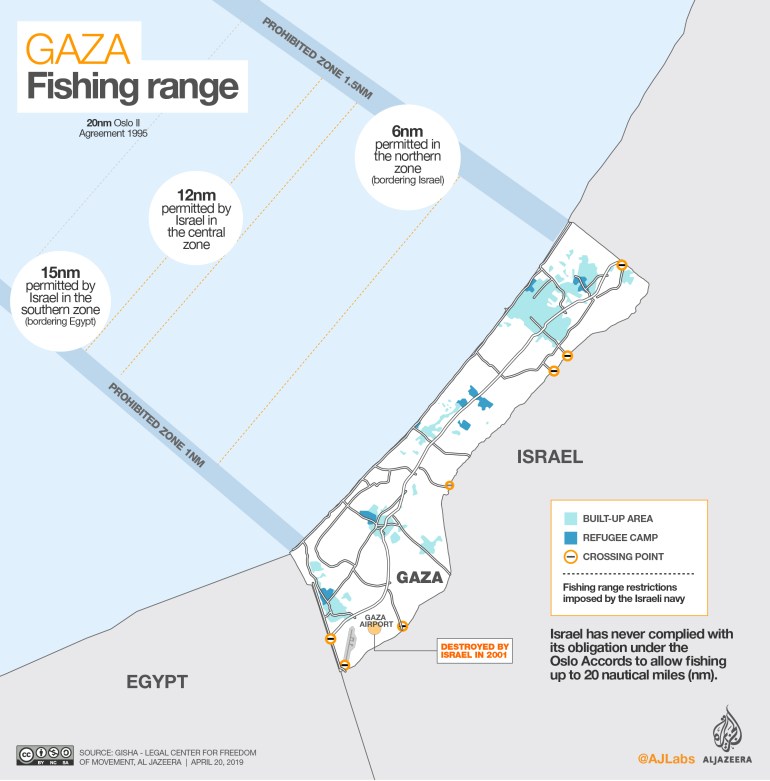Building materials allowed into Gaza after Israeli assault in May
While dozens of truckloads of construction materials were allowed into the besieged enclave, rights group says ‘more expansive opening’ is needed.

Dozens of truckloads of construction materials were allowed into the ravaged Gaza Strip, slightly easing a crippling 14-year-old blockade on the beleaguered enclave that was further tightened since an 11-day deadly assault ended last May.
The imports came days after hundreds of Palestinians in Gaza protested along the border fence with Israel to pressure it into lifting its siege and allow the reconstruction of Gaza following its relentless offensive. It also came as Palestinians launched incendiary balloons that sparked multiple fires in Israel’s south.
Keep reading
list of 4 itemsEgypt partially reopens Rafah border crossing with Gaza
In a bid to ease tensions, Israel says will allow goods into Gaza
In Pictures: Palestinians protest in Gaza Strip
Two Palestinians – including a 12-year-old boy – died of their wounds last week after being shot by Israeli gunfire, while at least 41 others were wounded. An Israeli soldier also died days after being shot at the fence by a Palestinian.
Bassam Ghabin, director of the Karam Abu Salem commercial crossing, said 30 truckloads of cement, 120 trucks of gravel and 15 trucks of steel entered Gaza on Tuesday. He said the materials began entering on Monday, and the crossing was operating almost at the same capacity as before the May attack.
The crossing is the primary passageway that transfers necessities to Gaza’s nearly two million residents, including cooking gas, wheat and flour. It also facilitates the delivery of much-needed foreign aid.
An Israeli security official, speaking on condition of anonymity under policy guidelines, confirmed building materials entered Gaza. He had no specific details, but said they came under previously announced government decisions.
‘Crucial but insufficient’
In recent weeks, COGAT, an Israeli military unit responsible for civilian matters in the occupied territories, said it was planning to allow more goods into Gaza if the security situation stabilised. Last week, it said it would “expand the entry of goods and equipment for international civilian projects in the Gaza Strip”.
Israel has tightened its blockade since the latest fighting in May. Thousands of homes were damaged or destroyed, and construction goods are badly needed.
Gisha, an Israeli human rights group that has pushed for an end to the closure, called Tuesday’s move “crucial but insufficient, especially given the scope of the damage in Gaza, as well as Israel’s legal and moral obligations towards residents of the strip”.
“The situation in Gaza is not simply a humanitarian crisis that can be managed via narrow humanitarian gestures,” Gisha said. “Any meaningful attempt at resolving this dire situation requires much more expansive opening of the strip, underpinned by a broader political process.”

Back to the sea
Meanwhile, Palestinian news agency Maan cited a COGAT statement on Tuesday as saying the fishing zone limit off the coast of Gaza will also be expanded to 15 nautical miles (28km). Israel routinely limits the zone to Gaza’s fishermen as a punitive measure in response to protests or Hamas policies, severely affecting the livelihoods of some 4,000 fishermen and at least 1,500 more people involved in the industry.
Under the Oslo Accords signed in 1993, Israel is obligated to permit fishing up to 20 nautical miles (37km), but this has never been implemented.
In practice, Israel only allowed fishing up to 12 nautical miles (22km) until 2006, when the fishing zone was reduced to six and later to three.
It also allowed for the water supply to be increased by an additional five million cubic metres.

The coastal enclave has suffered from years of Israeli and Egyptian blockades, as well as foreign aid cuts by the United States.
The May offensive was the fourth major Israeli assault on the Gaza Strip since Hamas took power there in 2007. At least 260 Palestinians were killed, including 67 children and 39 women, according to the Gaza health ministry, while 13 people were killed in Israel.
Palestinians in Gaza held another nighttime demonstration along the fence with Israel to call for a lifting of the blockade. Gaza health officials said three Palestinians were lightly wounded by Israeli gunfire.
Egyptian mediators have been trying to broker a longer-term ceasefire. But Israel has demanded the return of the remains of two Israeli soldiers and freeing of two Israeli civilians in Hamas captivity.